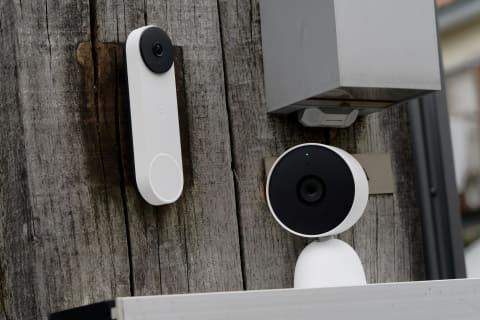"Portable Wi-Fi" Review
25/03/2022

The correct product name for Nest Doorbell is "Google Nest Doorbell (Battery Type)". It's a wireless intercom with a built-in battery. It has a vertically long body and a simple design with only a camera lens and a large call button on the front, but it has a built-in battery, so it feels solid when you hold it in your hand.
Around the front lens.When a really simple person approaches, it detects it and the area around the button at the bottom glows brightly.Use the familiar "Google Home" app for setup. Like other Google products and other smart home products, Nest Doorbell will be added as a new device from "Device Setup" in the Google Home app. It's easy because you just read the QR code of the product and follow the instructions on the screen.
The initial setting is to read the QR code on the back from "Device setup" of the "Google Home" application and proceed with the setup Detailed explanation such as installation method is displayed at the beginningIt operates on the built-in battery and cannot be used while supplying power to the Type-C port for charging (there is another way to use it while supplying power), so it will be installed in the place where you want to install it as an intercom after charging it in advance. The most troublesome thing is probably the installation work.
The back side of the main body.Charge with the Type-C port on the right
As a general premise, the place where Nest Doorbell can be used is limited to the place where it can be fixed with "screws". This is because the attached dedicated pedestal must be used for mounting, and the method of fixing the pedestal is a screw. This seems to be mainly due to anti-theft measures. When the main body is set on the pedestal, the main body can only be removed with a special tool.
When the battery is low, it will be brought into the house regularly for charging, so the convenience at that time is also important. Thanks to the method that uses a special tool, it takes less time to remove it when charging while taking minimum anti-theft measures.
However, by using screws, the fixing destination will be "wood" in principle. If you want to fix it to a metal pole such as a multifunctional gate pillar that is often seen in detached houses, or to a concrete wall, you need to make a separate hole and take a lot of time and effort.
At the author's house, I decided to remove the existing intercom on the gatepost and install the Nest Doorbell instead. First, attach a pedestal that can be angled in the left-right direction. This can be omitted. Next, attach the metal pedestal to which the main body is fixed.The existing intercom wiring is wrapped with tape for the time being and pushed into the gap to complete the installation of the main bodyIt's not surprising that it can't be attached to the front door because it's called a "doorbell," but it's actually difficult. I would like to make a metal entrance door removable with a magnet, but that raises the issue of theft. It seems that it can be installed if it is a wooden entrance door, but most of the entrance doors sold for residential use are made of wood on the surface but made of steel plate inside. It is not something that is forcibly processed to reduce the security performance of the entrance door.
Fortunately, the author's house used sleepers for the gatepost, so all I had to do was remove the existing intercom and attach it there. However, it is necessary to pay attention to the mounting height. As I will explain in detail later, Nest Doorbell also has a function to recognize luggage placed on the ground, so the installation height is also specified strictly to some extent so that it can be seen by the camera (vertical field of view even as a camera lens). Is getting wider). The author's house is a road where cars pass in front of me, and there is no possibility that luggage will be placed, so I installed it with the feeling that it would be nice if visitors could be seen for the time being.
Detailed screen of Nest Doorbell opened from Google Home app When live video is displayed (background has been blurred)Also, since Nest Doobell has IP54 drip-proof and dust-proof performance, it can be used outdoors for the time being, but it should be noted that it is not completely "waterproof". The drip-proof performance is at the "protection against splashes" level, and "it is not harmfully affected by water splashes from any direction." It doesn't seem to be a problem if it rains lightly, but I'm worried that the downpour will continue to hit directly. I would like to think about ways to prevent rain to some extent.
There seems to be no problem even if it rains a little.But I'm worried that I'll be exposed to downpour and direct sunlight all the time.There is one more note. Since this product is used for wireless communication via Wi-Fi, it is natural to confirm that the installation location is within the reach of home Wi-Fi. If the Wi-Fi signal is hard to reach, live video playback may be awkward. In that case, change the location of the Wi-Fi router itself or add a Wi-Fi router indoors as close as possible to the Nest Doorbell. It will be necessary to consider improving the network environment such as.